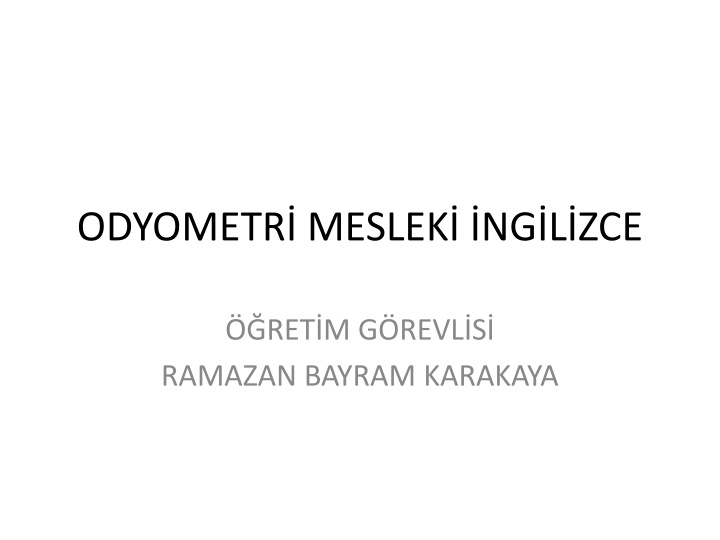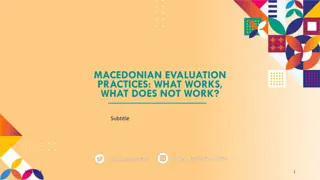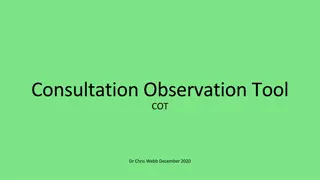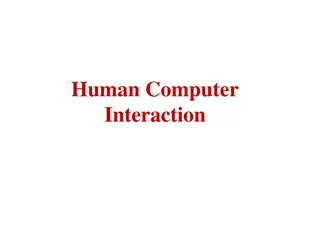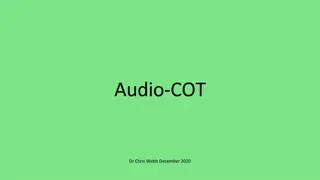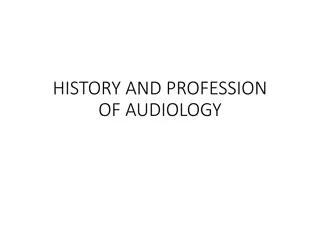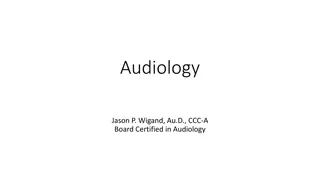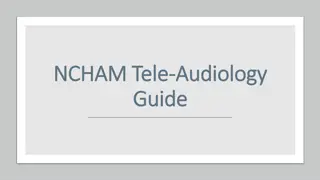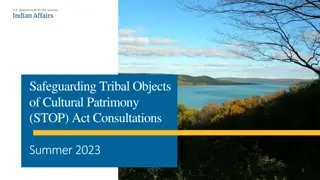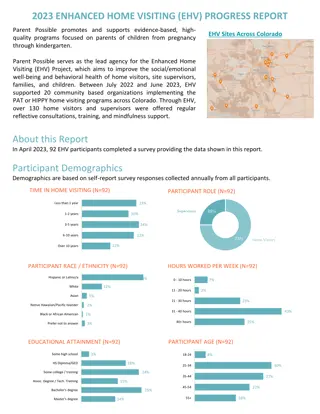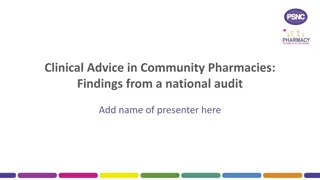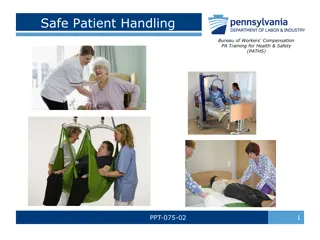Best Practices in Audiology Consultations: Patient Interaction and Evaluation
The content discusses essential tools in creating a case history, the importance of recognizing warning signs in audiology, and a scenario highlighting proper patient interaction during an audiometric evaluation. It emphasizes professionalism, thorough assessment, and referral protocols for audiologists.
Download Presentation

Please find below an Image/Link to download the presentation.
The content on the website is provided AS IS for your information and personal use only. It may not be sold, licensed, or shared on other websites without obtaining consent from the author.If you encounter any issues during the download, it is possible that the publisher has removed the file from their server.
You are allowed to download the files provided on this website for personal or commercial use, subject to the condition that they are used lawfully. All files are the property of their respective owners.
The content on the website is provided AS IS for your information and personal use only. It may not be sold, licensed, or shared on other websites without obtaining consent from the author.
E N D
Presentation Transcript
ODYOMETR MESLEK NGLZCE RET M G REVL S RAMAZAN BAYRAM KARAKAYA
There are three primary tools used to create a case history: Interviews, questionnaires and the subjective, objective assessment and plan (SOAP) format. These three tools are often used in tandem, but can certainly be used as preferred by the professional.
The audiologist must be aware of the warning signs of dangerous and treatable medical and surgical conditions and should refer to the appropriate professional when red flags are noticed.
Red flags include a sudden hearing loss, ear pain, draining or bleeding ears, unilateral symptoms of hearing loss or tinnitus, conductive hearing loss, dizziness, and other referral criteria.
SCENARIO ONE Review any/all assembled paperwork (chart, lab notes, test results, history, etc.) before meeting the patient for the initial consultation. Shake hands and greet the patient, their spouse, significant other, family, and so on, and always introduce yourself. This is an amazingly simple protocol, but it is often overlooked, and when it is overlooked, it sets an unprofessional tone for the rest of the encounter. I usually say, Good morning. My name is Dr. Beck, I m an audiologist. Please come in Mr. Smith.
SCENARIO ONE After exchanging greetings and after sitting down in the office, inquire as to why the patient scheduled today s visit. Thanks for coming in today Mr. Smith. What brings you to the office?
SCENARIO ONE Mr. Smith: I would like a comprehensive audiometric evaluation to confirm my bilateral sensory/neural noise-induced hearing loss that my otolaryngologist diagnosed last week. I am very interested in acquiring two digital hearing aids, and by the way, I am wealthy and do not have insurance. I pay cash, and money is no object. I want to hear everything as best I can.
SCENARIO ONE Because this patient has already been seen and diagnosed by the ear, nose, and throat (ENT) specialist, the index of suspicion for some other disease process or a medical/ surgical issue is extremely low.
SCENARIO TWO Mr. Smith: Well doc, you know how it is. My wife always complains I have the TV up too loud and it drives her outta the room. I like to be able to hear the darn thing so I keep it a little loud. The same thing happens with the car radio when we re driving to the store. When she sets the volume, I just hear noise and can t tell anything about what they re saying. When I was a boy, I could hear a pin drop from 40 paces.
SCENARIO TWO I understand. How long have you been playing the TV and radio louder than your wife likes it?
SCENARIO TWO Let s see, I started working at the steel fabrication factory 14 years ago, and my son was born 8 years ago . . . . so yeah, it s been at least 8 or 10 years. When I let her set the volume, I can hear the voices, but I really can t understand what they re saying. That drives me nuts. I told her and I m telling you too, I ain t gonna wear no hearing aids.
SCENARIO TWO Given the information presented in this scenario, one can make several, reasonable, assumptions. We could assume that Mr. Smith has a noise- induced SNHL, likely impacting 4,000 Hz, and because he cannot hear the consonant sounds (high frequencies), he cannot clearly understand the words spoken to him. We might also assume that Mr. Smith is not going to wear hearing aids and that there is little we can do to assist. However, there are other options and protocols to employ:
SCENARIO TWO Mr. Smith, have you had a hearing test before? Not since the Army, back some 20 years ago. Do both ears seem about the same, or is one ear better than the other? The left ear is terrible can t hear thunder with that one. I see. Do you have any ear pain? None at all. My ears feel fine. Okay then. May I take a look? Sure, help yourself.
SCENARIO TWO At this point, the audiologist has a rather low index of suspicion for a tumor, such as an acoustic neuroma, because they occur in about 0.00001% of the population, but a higher index of suspicion for more likely possibilities, including a unilateral sudden sensory/neural loss that went undiagnosed (or maybe Mr. Smith works with his left ear toward a loud machine while wearing hearing protection only in the right ear, or perhaps he experienced head trauma on the left or an explosion near his left side during boot camp; there are lots of possibilities). The examination of the pinna, concha, ear canal, and tympanic membranes is normal. The audiologist says, Okay, your ears look fine, and the interview continues to determine which diagnosis has the highest index of suspicion.
SCENARIO TWO Mr. Smith, let me make sure I understand . . . the right ear is the better ear and the left ear has been bad for a long time. Have you ever had the left ear checked?
SCENARIO TWO Yes. I had the doctor look at it a year or two ago when it went bad. He put me on antibiotics and that was the end of it. It didn t get better though, so I left it alone.
SCENARIO TWO Okay. What about drainage, anything coming out of your ears? No sir. Any dizziness or spinning sensations? Not any more. Well, maybe a little. When my left ear was going bad, I had some dizziness, but the doctor looked at it and put me on antibiotics, and the dizziness got better after a while. So the dizziness started and the left ear went bad all about a year or two ago? That s right. Okay, very good. Are you on any medications? Just a cholesterol pill and a baby aspirin, that s about it.
SCENARIO TWO Okay, and one last thing I d like to ask you before we do the hearing test do you have any ringing or buzzing noises in your ears? Yeah, the darn left ear can t hear anything, but it sure makes a racket. Kinda like a shhhhh noise going on in there. Keeps me up at night sometimes.
SCENARIO TWO The audiologist does a comprehensive audiometric evaluation and determines the following audiometric profile: Right ear: Normal peripheral hearing. Tympanogram normal (type A), ipsilateral reflexes within normal limits (WNL). Word recognition score (WRS) = 96%. Speech reception threshold (SRT) = 15 dB HL. Left ear: Flat 85 dB sensory/neural (SN) loss. Tympanogram normal (type A), ipsilateral reflexes absent @105 dB stimulus level. WRS = 8%, SRT = SAT (speech awareness threshold used because speech understanding was extremely poor) = 80 dB HL.
SCENARIO TWO The index of suspicion for a left retrocochlear disorder is very high at this point. The case history supports this possibility, and the test results indicate a possible retrocochlear diagnosis for the left ear.
SCENARIO TWO The audiologist refers the patient to an otolaryngologist (preferably an otologist or neurotologist) based on the high index of suspicion for a retrocochlear hearing loss. The otologist meets with and interviews the patient and refers the patient for a magnetic resonance imaging (MRI) study with contrast (gadolinium). A 3-cm vestibular schwannoma (acoustic neuroma) is diagnosed. Mr. Smith is scheduled for surgery 3 weeks later, and the tumor is removed via the translabyrinthine approach.
SCENARIO THREE Mr. Smith: Let s see, I started working at this really noisy factory 14 years ago, and my son was born 8 years ago . . . so yeah, it s been at least 8 or 10 years. When my wife sets the TV, it sounds like everyone is mumbling; I can hear the voices, but I really can t understand what they re saying. That drives me nuts. I told her and I m telling you too, I ain t gonna wear no hearing aids.
Given the information presented above, one can make several assumptions. We could assume Mr. Smith has a noise-induced SNHL, impacting frequencies around 4,000 Hz, and because of the reduced amplitude and distortion affecting mostly the high-frequency consonant sounds, he cannot clearly hear the words spoken to him. We can also be comfortable in thinking that Mr. Smith is not going to wear hearing aids, which reduces what we can do to assist him. However, there are other options and protocols to explore.
SCENARIO THREE Mr. Smith, have you had a hearing test before? Not since the Army, back some 20 years ago. Do both ears seem about the same, or is one ear better than the other? They re just about the same I see. Any ear pain? None at all. My ears feel fine. That s good. May I take a look? Sure doc, knock yourself out.
SCENARIO THREE The pinna, concha, ear canal, and tympanic membranes are normal in appearance. The audiologist says, Your ears look fine, and the interview continues. Okay, what about drainage? Is there anything coming out of your ears? No sir. Any dizziness or spinning sensations Nope. Very good. Are you taking any medications? Just a cholesterol pill and a baby aspirin, that s about it. The last question I d like to ask you before we do the hearing test is do you have any ringing or buzzing noises in your ears? Yeah . . . maybe a little when it s really quiet, nothing that really bothers me though.
The audiologist does a comprehensive audiometric evaluation and determines the following audiometric profile: Right ear: Moderate high-frequency sensory/neural hearing loss. Tympanogram normal (type A), ipsilateral reflexes are within normal limits (WNL). WRS = 96%. SRT = 45 dB HL. Left ear: Moderate high-frequency sensory/neural hearing loss. Tympanogram normal (type A), ipsilateral reflexes are WNL. WRS = 92%. SRT = 45 dB HL.
Mr. Smith, Id like to review the results of todays tests with you. Would you like to have your wife join us while I review the results? Sure, that would be great. She s in the waiting room. Hi Mrs. Smith, please join us while I review the results of today s examination. This way, the two of you will have the chance to learn about the results, and I can address your questions.
Case 1/CASE HISTORY Mr. Ang Kim, age 36, is being seen today after he failed the hearing screening at his company s health fair. His medical history is generally unremarkable, though he reports that he is just getting over a sinus infection and recently underwent surgery for a slipped disc in his back. You have back to back patients today and because there is nothing remarkable in his history you decide to do a quick audiogram and send him on his way. Results from otoscopy, puretone, and speech audiometry are shown in Table 8.3 and Figure 8.2. With subjective information alone this audiogram could indicate many things. For example, you may inaccurately diagnose Mr. Kim with a collapsed ear canal, an impacted cerumen plug, or a perforated tympanic membrane without additional tests to cross check your findings.
Despite your busy schedule, you decide you need more information to make an accurate diagnosis, so you perform objective testing to cross check your subjective results. The results from immittance testing and OAE testing are shown in Tables 8.4 8.6. With this information, you have several different tests to confirm your finding of a conductive hearing loss. The Type B tympanogram in the right ear reveals normal ear canal volume but no mobility. The normal ear canal volume suggests that the TM is not perforated and there is no cerumen plug. The pattern of the ARTs is consistent with a right conductive pathology. TEOAEs in the right ear are absent which is expected with a conductive pathology. The combination of the subjective and objective test results correctly leads you to suspect otitis media with effusion and would require a referral for Mr. Kim to a physician. In this case, you are able to make an appropriate referral based on the information you obtained from a test battery incorporating both objective and subjective measures.
